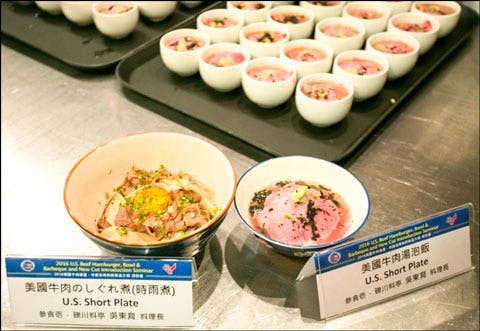Seminar Helps U.S. Beef Further Penetrate Taiwan’s Food Culture
As part of an ongoing effort to further establish U.S. beef as a key component of Taiwan’s food culture, USMEF hosted a U.S. beef bowl and barbecue seminar for 60 Taiwanese importers, foodservice managers and restaurant operators. Building on a very popular consumer event held last year, the seminar was funded by the Beef Checkoff Program.

Chef Dongyu Wu demonstrated creative and cost-effective ways to make beef bowls using U.S. beef short plate at the U.S. Beef Bowl Seminar in Taiwan
Professor Yunchu Wu, of the Department of Animal Science and Biotechnology at Tunghai University, was a primary presenter at the day-long seminar. A red meat expert who specializes in quality control, new product development and food safety, Yunchu Wu shared his views on top sirloin cap, an alternative cut of U.S. beef that offers great value and versatility. He recommended seasonings that bring out the flavor of the cut, adding that its leanness makes the sirloin cap a healthy option. The presentation was extremely beneficial for attendees, especially the younger Taiwanese restaurant managers who are relatively new to the industry.
The approach also fit perfectly with one of USMEF’s key strategies in the Taiwan market.
“USMEF-Taiwan has been reaching out to more independent restaurants that have been consistently using U.S. beef – we’d like to recruit them as a new generation of customers for U.S. beef,” said Davis Wu, USMEF director in Taiwan. “One characteristic these customers have in common is the owners are all in their late 20s or early 30s who decided to be their own boss. Small restaurants often do not have access to the information they need to learn the benefits of U.S. beef, nor do they have the marketing resources. But USMEF is anxious to include them in an umbrella promotion and educate them about the value and advantages of U.S. beef.”
The promotion of economical cuts has been a focus for USMEF in Taiwan for several years, Davis Wu noted.
“The effort has paid off, as we see importers push economical cuts to their clients, and various U.S. packers are continually supplying petite tender, clod heart and plate fingers to Taiwan. And this year, we have added sirloin cap to the list,” he said.
Another presenter at the seminar was from the All Japan Yakiniku Association, a Japanese professional organization that promotes yakiniku-style dining. Many participants in the U.S. beef bowl seminar operate Japanese restaurants, Davis Wu explained, so “providing an overview of the Japanese Yakiniku Industry, dining style and the introduction of different yakiniku sauces was very effective,” he added.

Taiwanese importers, foodservice managers and restaurateurs were given new menu ideas that utilize the advantages of U.S. beef
Chef Dongyu Wu concluded the seminar with a cooking demonstration. A young chef himself at 29, Dongyu Wu has co-owned two Japanese restaurants. As a starter dish for the seminar, he used U.S. beef short plate to make a beef bowl. He explained that when he first trimmed the short plate, he saw the yield loss as a waste and came up with an idea to utilize it – turning the yield loss into beef stock and creating another form of beef bowl. He called it “beef stock over beef bowl.”

Attendees tasted U.S. beef bowls prepared at the demonstration
As Dongyu Wu pointed out during his cooking demonstration, the USMEF seminar’s ultimate goal was to “give restaurants ideas on how U.S. beef could be utilized in different ways, and in ways that could turn yield losses into profit.”
